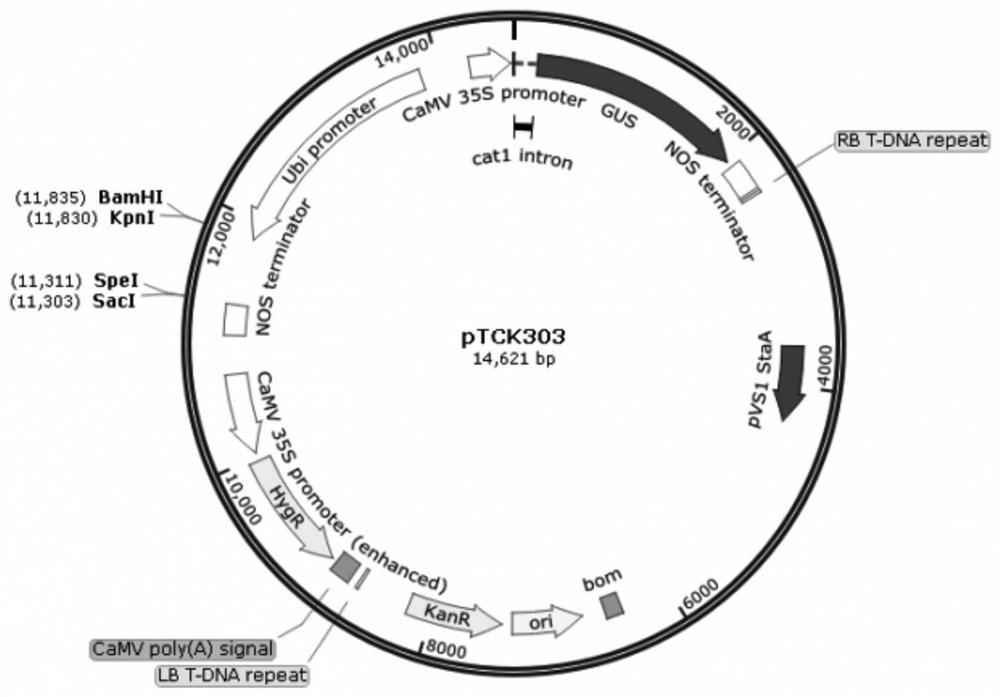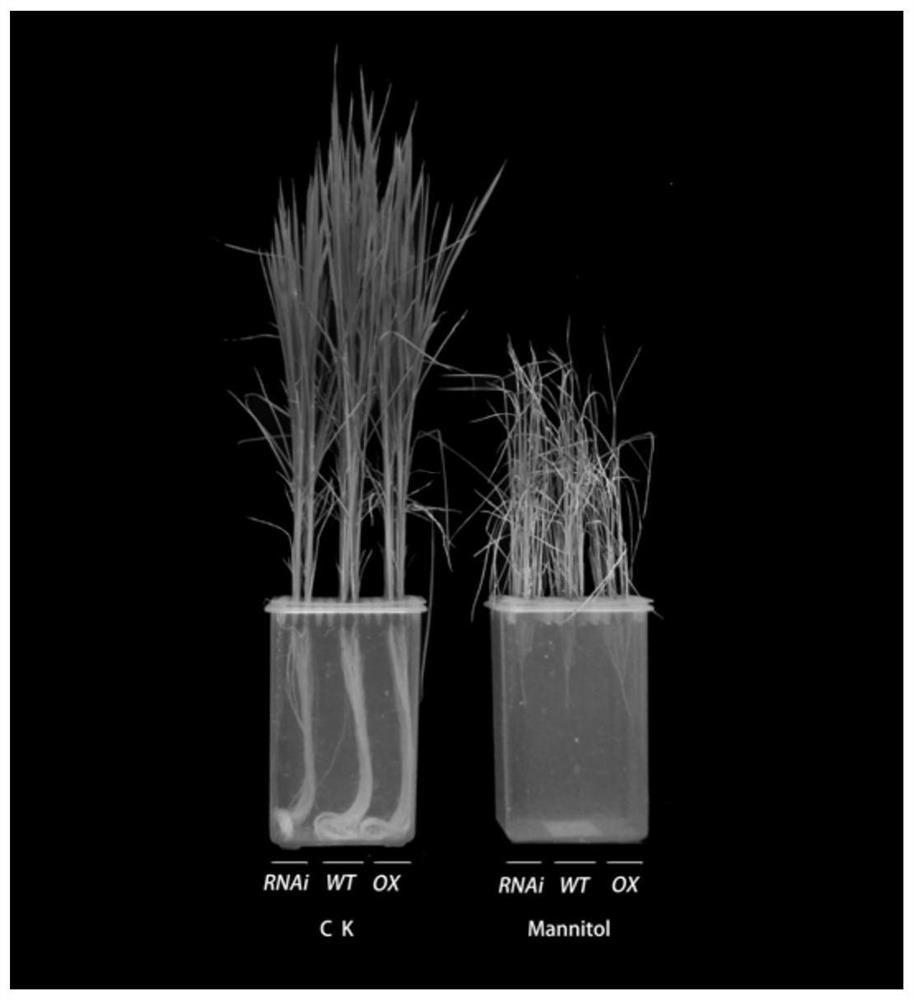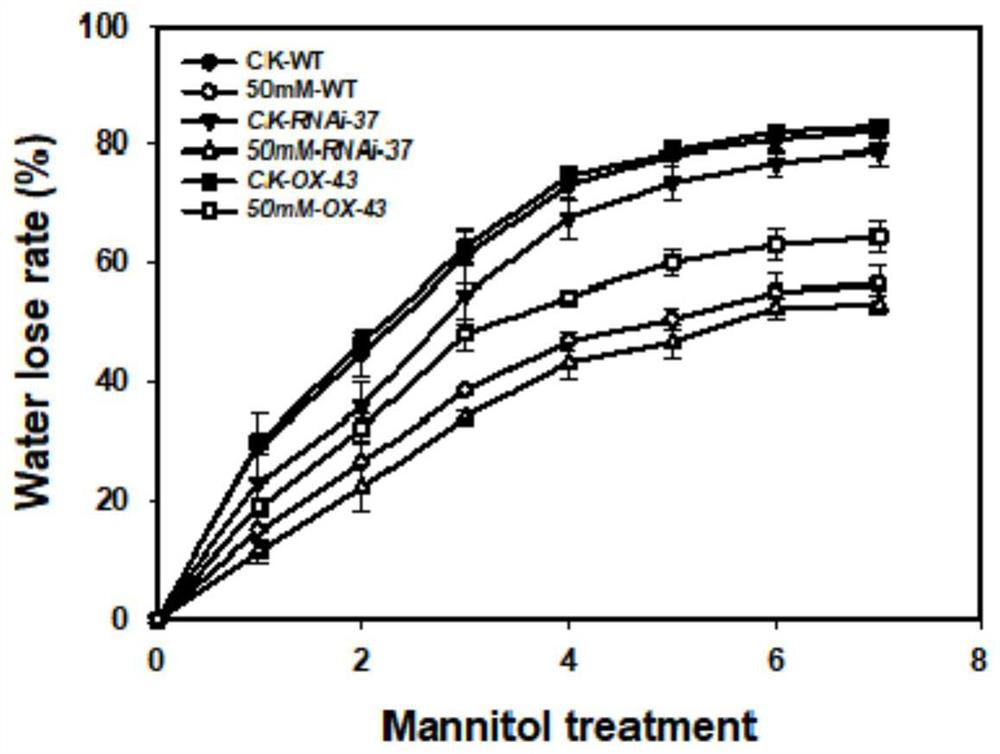Use of rice osmotic stress response protein OsU496A in improving osmotic stress resistance of rice
An osmotic stress, anti-osmotic technology, applied in the application, recombinant DNA technology, chemical instruments and methods, etc., can solve the problems of rice morphology, internal physiological environment and metabolism changes, plant death, plant growth retardation and other problems
- Summary
- Abstract
- Description
- Claims
- Application Information
AI Technical Summary
Problems solved by technology
Method used
Image
Examples
Embodiment example 1
[0083] Example 1: Construction of an interference expression vector and an overexpression vector of the OsU496A gene.
[0084] 1.1 Construct the interference expression vector of OsU496A gene;
[0085] The OsU496A interference expression vector is constructed by reversely connecting a segment of target sequence SEQ ID No: 4 at both ends of the intron of the vector. Specific method: Design specific amplification primers for the target sequence SEQIDNo: 4, add SacI and SpeI restriction sites at the end of the primers, and the primer sequences are F: 5'-GGTACCACTAGTAGCAGCCTCCACACCCTCG-3' and R: 5'-GGATCCGAGCTCTCGATCCACTTCCCCATA-3' . The total RNA of rice leaves was extracted using the Plant RNA Extraction Kit of Kangwei Century Company. The described rice leaf total RNA is according to the ReverAid of Quanshijin Company TM FirstStrandcDNASynthesisKit Product Description Perform reverse transcription to obtain the first-strand cDNA of rice leaves. Using cDNA as a template, the...
Embodiment example 2
[0096] Implementation case 2: Interfering expression of pTCK303-iU496A and overexpression of pTCK303-0sU496A recombinant vector transforming rice plants;
[0097] After verifying that the constructed interference expression pTCK303-iU496A and overexpression pTCK303-OsU496A recombinant vectors are correct, they were transferred into Agrobacterium EHA105. The specific steps are as follows:
[0098] (a) Add 2 μL of the recombinant plasmid to 100 μL of Agrobacterium competent, and mix slightly;
[0099] (b) Stand on ice for 5 minutes;
[0100] (c) Immerse in liquid nitrogen for 5 minutes;
[0101] (d) 37°C water bath for 5 minutes;
[0102] (e) Stand on ice for 5 minutes;
[0103] (f) Add 700 μL of liquid LB medium, shake at 28°C / 200rpm for 2-3 hours;
[0104] (g) Take 200 μL of bacterial liquid and spread it on the LB plate containing kanamycin and rifampicin;
[0105] (h) Inverted and placed in an incubator at 28°C for 2-3 days.
[0106] Then, the recombinant plasmids were...
Embodiment example 3
[0107] Implementation case 3: Phenotype analysis of OsU496A interference expression lines and overexpression lines under osmotic stress;
[0108] The RNAi-OsU496A, wild-type and OX-OsU496A seeds with consistent germination were cultured in IRRI nutrient solution for 10 days, and then treated with 50 mM mannitol solution. After treatment, the phenotypes of the strains were significantly different. The wilting degree of the RNAi-OsU496A strain was significantly lower than that of the wild type and the overexpression strain, and the wilting degree of the overexpression strain was the most serious. It can be seen that the interference expression strain is resistant to osmotic stress. ability is better than wild type, and wild type is better than overexpression ( figure 2 ).
PUM
 Login to View More
Login to View More Abstract
Description
Claims
Application Information
 Login to View More
Login to View More - R&D
- Intellectual Property
- Life Sciences
- Materials
- Tech Scout
- Unparalleled Data Quality
- Higher Quality Content
- 60% Fewer Hallucinations
Browse by: Latest US Patents, China's latest patents, Technical Efficacy Thesaurus, Application Domain, Technology Topic, Popular Technical Reports.
© 2025 PatSnap. All rights reserved.Legal|Privacy policy|Modern Slavery Act Transparency Statement|Sitemap|About US| Contact US: help@patsnap.com



